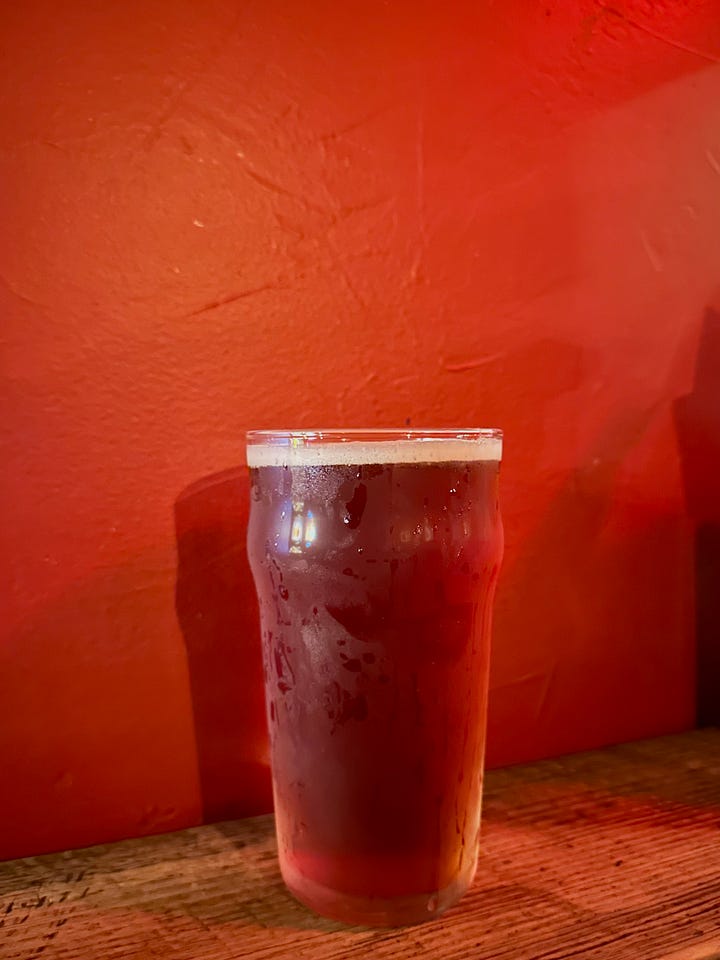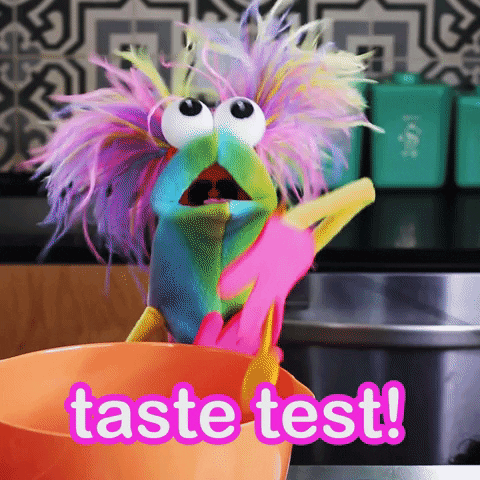89. New Flavors, New Favorites, New Beer-Tasting References
Venturing outside our routines when we can is just plain good for our beer-tasting skills; the biggest overarching stories in craft beer now; plus, tarot for multitasking.
Adventures in Flavor Experience Expansion
Back in September, I dove deep on the language we use when we’re tasting and describing beer (and wine, and hard seltzer…) specifically through the lens of how we can be more inclusive. How can we make beer more accessible? How can we connect to more people using more approachable reference points?
There’s another aspect of this conversation, though, and that is that we also have the power to level up our own beer-tasting experience by building our own personal flavor and aroma libraries. As nearly everyone I spoke to for that past newsletter issue pointed out, the problem with using really specific flavor comparisons often is that few people actually have any relationship with them—like, how many people know what “horse blanket” actually means? The inclusivity of language is priority number one, especially considering how much of this comes down to access and the fact that it’s often not even possible for many of us to find some of the things beer flavors and aromas are being described as. But when we can, it can be a pretty wonderful thing to take advantage of.
This came up for me yet again as I’m working on a story for which Asian ingredients and flavors in hard seltzer factor in. (I wish I could share more because there were two frankly inspiring interviews for this, but I’ll have to wait for the story to go up and will share then!) Research and conversations have crystallized the point that for many people, these beverages might be their first introduction to the flavor of the ingredient at hand. Or, maybe they’ve experienced that flavor in some capacity, but it often isn’t the via the natural ingredient itself. Take lychee. Plenty of folks here in the States have never had a lychee, or they’ve only had a super-sweet lychee martini. Trying an actual lychee, or even lychee in something like a craft seltzer where the natural ingredient is used, might be a surprise. And before this, if someone was to say, “this drink tastes like lychee,” they wouldn’t really be able to understand that or connect it with anything.
It’s a pretty beautiful thing about something like Asian flavors and ingredients in hard seltzer, that this category can at once speak to an entire community, bringing to life flavors they know from their families and childhoods, and introduce an entirely new audience to these flavors and even build wider-reaching appreciation. Working on this story, tbh, has given me new appreciation for (craft) hard seltzer—beer geeks might mock the simplicity of its base, but it’s a perfect blank canvas for letting these flavors shine. And if something accessible like hard seltzer can in turn make more flavors from different parts of the world accessible, too, that’s a win.
All this in mind, I took advantage of being in New Jersey this past weekend to head to H Mart. Okay, I was also there to stock up on Turtle Chips, gochugang, and tteokbokki, but I promise, this flavor mission was equally important. I bought Asian pears, mangosteen, Thai guava, and, after not finding lychee, I discovered something new to me: longan berries. How different would Asian pears taste? Did mangosteen taste anything like mango? Had I actually really never had guava itself, and only artificially flavored candies and beverages? And…what exactly were longan berries?
So far, I can tell you that I much prefer Asian pears, which I think has a lot to do with texture—their ripeness still comes with a nice firm crispness. Something about that snap enhances its sweet pear flavor but also counters it—it’s the balance of just a touch of tartness and that bite that keeps the sweetness in check. Thai guava turned out to be something different from my expectations entirely—to compare some of these back to my own familiar references, it was like a firm, short, green apple, tart, bright, sweet, and almost a tiny bit savory, too. I haven’t gotten to the mangosteen—bad reporting, I know—but so far, my favorite is the longan berries. They feel like eating a peeled grape and, to me, had the most complex flavor—dark cherry, cherry blossom (something subtly floral was happening), overripe plum, and…stay with me here…cotton candy, if there was like a natural form of cotton candy that grew from the earth. If you could be like, “Ugh, I don’t eat that fake pink and blue crap at the carnival, I prefer my cotton candy real and organic.”
It’s addictive, too: I want to get out there and start hunting down more new-to-me fruits, herbs, spices, and botanicals. I’m excited to add a few new reference points to my little personal tasting library. And, remember, a lot of this comes back to how we can all have an ongoing conversation about these ingredients and flavors, helping each other connect. I wouldn’t tell someone I think a beer has a longan note if they’ve never had it without fully discussing what that means—and hopefully it would encourage them to go seek the fruit out. We don’t always have access, but we should take full advantage when we do, and we should help each other with this adventure, too.
What are the Biggest Stories in Craft Beer Now?
I had the pleasure of joining in on a drinks journalism panel this past weekend with some lovely folks, and one of the points of the discussion was a question I’ve noticed I’ve been asked more than ever just in the past few months: what are the biggest, most needle-moving stories in craft beer right now? Here’s what I think they are—but what’s interesting is that while there are a few trends that are hard to argue with as monumentally important, beyond that, what we see as the most impactful stories to be following really says a lot about us, what matters to us, our interests, and our perspectives. I’d love to know what some of you think are the most compelling and fascinating stories in the industry presently!
DEI initiatives, efforts, and progress. For this one, it gets a little exasperating, because it’s hard to imagine not seeing this umbrella of stories as most urgent and necessary and yet we know plenty of people don’t. They should remember that the craft beer industry shouldn’t even continue to exist without continuous improvement in equity and inclusivity, and that it very well may not—while it’d be great if everyone made meaningful changes in this area because they believed in them, I think many of us will also take the resulting improvement from people who make these changes because it’s just good business sense. It’s not good business sense to keep your head in the sand and exclude entire communities. If you have a soul, DEI endeavors and check-ins with how the industry matter more than anything, but even if you don’t, they have a massive impact on how this industry fares over coming years.
The next few could all be filed under “ways the entire industry is changing.” First of all, while this isn’t a brand new phenomenon, I’d argue there’s more pressure than ever on breweries to be making beverages beyond beer. And non-alcoholic drinks, which I think is undeniably a good thing from every angle for the inclusivity and access it fosters. But while there’s a number of breweries who can rest on their devoted followings for their lagers or IPAs, there are even more who need to branch out into other categories in order to keep attracting people to their taprooms and/or compete for shelf space in retail. Of course there are breweries who want to venture out anyway, for the sake of creativity, but there will always be plenty who simply see this move as an imperative to stay relevant and therefore stay…open.
Another thing many breweries find themselves needing to focus on maybe more than ever is taproom experience. Again, this isn’t breaking news, but it is something that’s just becoming more wide-reaching—very few breweries, I think, are safe from having to make sure their taprooms are a good and maybe at least somewhat unique hang rather than assuming their beer will do all the heavy lifting on its own. As the middle of craft breweries gets squeezed—a smaller number into a top tier that distributes across multiple states, a larger tier of producers focused on their local footprint—it’s becoming increasingly important for most breweries to make sure their taprooms are a draw, with perhaps more of the kind of intention one might have when opening a restaurant. Some will keep coming for your beer no matter what the atmosphere is, sure, but for most, it’s about the whole package.
On that note, multiple taproom locations! In some cases, this is the territory of those few breweries who also distribute pretty widely, and are in general bigger operations. In others, it’s the territory of breweries who are indeed focusing on that taproom over distribution. As this trend continues to grow, it’s pretty interesting to see who’s expanding, where, whether their different locations are actually offering anything different (barrel-aging? Lager focus? More live events? Food?), and what drives how they grow.
On the flipside, we have a growth of what I think you’d categorize more as brands than breweries. With the staggering costs of opening a brewery and the diminishing promise of success, many are choosing to stay nimble, scrappy, and small. They’re leaning into contract brewing and nomadic brewing and collaborations. They’re keeping their portfolios tight with two or three core offerings with the potential for seasonal one-offs. Some of them will go on to open spaces based on their own unique combinations of success and ambitions, some of them will stay in this state that feels more flexible—and very importantly, this route is one that creates more access, as it’s an inroad into making beer professionally that doesn’t require the immense capital your own space from the get-go would require. Think Back Home Beer, or some of the brands coming out of Twelve Percent Beer Project…or Pilot Project, like Funkytown or the newly commercial(!) Flora Brewing.
Sustainability! This is only landing at number six because numbers two to five felt directly linked (it’s all linked to an extent, of course), but is quite obviously direly urgent because, you know…the planet’s on fire! I personally feel pretty inspired by how many brewers seem dedicated to figuring out more eco-friendly systems. Admittedly, this is a world I’m only starting to dive deeper into in terms of technical details and fully understanding it all, but I’m excited about sustainability in terms of brewing systems, hops, and malt—and the two-way street of how breweries evolve into more sustainable operations alongside how the changing planet impacts brewing couldn’t be more important.
So, what else? Obviously, the entire ecosystem of mergers and acquisitions factors in quite heavily here, somewhere in that two-to-five, changing-business field. It’s not my personal area of expertise but is naturally an area anyone writing about beer has to keep a close eye on at least for context. What are you feeling is an important area to be focusing on now within beer?
Beer Tarot!
This week, I pulled the Two of Pentacles.
Pentacles as a suit speaks to money, property, and achievement, and the Two of Pentacles is—as you can see—about a sort of juggling act in this area. Time management, multitasking, having more than one or two or even three priorities. This is the card for working parents (though that feels like a redundant term, doesn’t it—all parents are working); people who have more than one job or even if they have one job, maybe they’re torn between pleasing consumers and management or their team and management; or maybe in general you’re torn between creativity and financial stability…the possibilities are endless. I started this sentence like, “oh, this card goes out to you folks who…” and then realized there’s probably no one alive right now not juggling a lot.
When this card comes up, it’s trying to tell you that you’ve got this. It’s telling you you’re doing a good job. Maybe you’re being hard on yourself, and you need this card to remind you that life is fucking tough and, actually, you’re doing pretty amazing work over there. You might think you’re not doing enough or not doing it all right, but maybe you just need to reframe your perspective. If you’re working and making time for people and things you love…you’re killing it, aren’t you? I know I need this card in a big way because I often feel like I’m failing when I look at what other freelance creatives are up to. I’m like…how do they have time to do both the work that really pays the bills and the dream creative projects and somehow read the entire internet daily and maybe even take care of a kid and also go on miles-long bike rides and cook entire dinners…??? But we have to keep reminding ourselves that no one is doing it all, and certainly not alone. Often, it all just looks like it on social media. In reality, the best thing we can do is narrow things down—what areas do we want our work to concentrate on, what goals do we want to achieve, are our lives in the position where we’re making more time for family or friends or ourselves or volunteering?—and keep reminding ourselves this is it. This is life, this is the ride, man, you’re on it and you’re doing it and you’re doing it pretty great.
When we forget this, and lose track of the main priorities that matter most to us and try to do everything and then get mad at ourselves when we inevitably fail, we can spin out of control, and things will just get worse. So, while the Two of Pentacles comes along to say, “good job, friend!” it also wants to remind you to stay on this track, stay focused, and be kind to yourself so that whole spiral doesn’t happen. And, hey, remind yourself of this with an IPA called Straight Priorities from Green Empire Brewing.
This Week’s Boozy Media Rec
This is from back in February but I just stumbled upon it and think it’s worth sharing. In a story written by Amanda Gabriele and Bonnie Stiernberg, Inside Hook’s team set out to decide whether wine or beer pairs better with cheese. It’s a fun read for a few reasons. One is that, spoiler, beer wins! Another, of course, is reading why. It’s a good source for those of us forever learning more about the art of pairing, simultaneously reminding us that for all the “rules,” or helpful guidance, at least, it’s all also subjective and personal and an area that needs to be left open for all palates and preferences. And a third reason is that this provides good inspiration for trying these cheeses, wines, and beers, and doing your own pairings. Don’t follow this story’s lead to the point of picking a Founder’s beer, I’d offer, but you know…fun, informative stuff.
Ex-BEER-ience of the Week


This week, in “We. Love. To. SEE IT.” news, brown ales and red ales are proliferating! I mean, let me calm down, it’s not exactly in wildfire territory yet, but relatively speaking? I think there’s reason to be excited. This week, I fell in love with a hoppy brown ale from Finback in collaboration with Heist Brew Co., and the very next night, I was at Bar Great Harry and there was a hoppy red ale from Mast Landing. Let’s get a chant going? MORE OF THIS, MORE OF THIS, MORE OF THIS…!
Until next week, here’s Darby at Finback—we entered her in their contest to be featured on an upcoming can and alas, she did not make it to the voting round, but I think she’s worthy of a beer can, don’t you?







